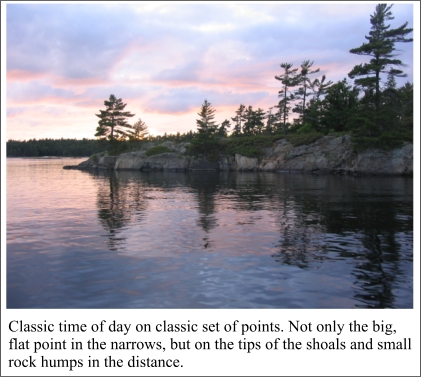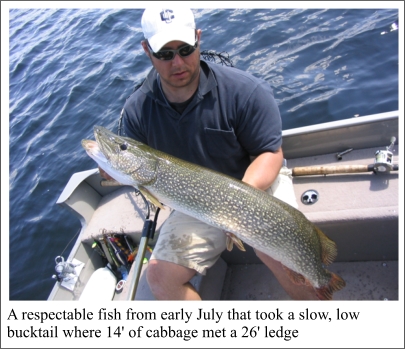Summer Pike Points Some are definitely better than others! Reading water and being able to carry out a logical fishing approach is the most important part of the process. You can have the sharpest hooks, make the perfect cast and work your lure correctly but if you're fishing dead water, not much will happen. On structure like points especially, making good use of lure depth and fishing angles is really important. For the most part, points are things that stick out, with more than one side. A shoreline wall, for example, has only one surface. Depending on their shape and layout, a point can have four, five, even six 'lanes' or sides to work. No matter the lake type, it's amazing to me how good points almost always have a similar mix of elements. For pike in the middle of the summer, the formula is actually really basic. So much so that is really has become cliché. We've heard it that many times! Put some deep water near it, on at least one of the sides. Add in some kind of lead-in cover like weeds or jumbled rock, and put it in a favorable location on the lake as it relates to travel, food and safety and you can hardly go wrong. Some points are steeper than others, some deeper, some weedier and some shallower. Some have extended shelves or ledges and some drop much quicker into basin-type water. Like any other kind of spot, make sure you have a mixture of them to test out during the trip. If I had to pick six to fish this evening, at least three of them would be directly facing water as deep as forty feet with a big shelf and lots of new cabbage weeds. It seems like the longer summer drags on, those spots on the main channel side, main lake side or windiest side produce best. They're prominent, normally large and normally directly fishable with the boat over deep water the bulk of the time. You might swing the boat up into or near water that's 12, 14 or 16 feet deep, but water twice that depth is always a cast away. It's been my experience that the largest, most noticeable projections with the most varied bottom type are the best. Smaller, more out of the way points produce big pike on occasion, but almost all my best big fish spots jump right out at you on a good map. They intersect spans of deep water, form travel barriers and just plain look 'fishy.' Are there spots on maps that look dynamite and turn out to be poor? I've fished lots over the years, for sure. But for the most part, good points are not hard to locate. Isolated, offshore structure with no shoreline links or spots for suspended pike take a lot more work to find and learn. Even a topo map of a lake with no depths will show you the major points to start checking. Speaking of other types of spots (shoals/humps, open water, narrows, walls) good points are almost always the sum of their surrounding parts. In addition to the cover they have themselves, like weeds or boulders, they almost always have good and different areas very close by. Points where a lake branches off or narrows down are a good example. Points that stick out into deep water where you always mark or catch other kinds of fish like trout or walleye are another. With enough work and attention, you're going to find that the best points might not actually have pike right on them, but reasonably close by from one visit to the next.
I always try to fish a spot from a new direction or angle every time I come back to it. On points, you've normally got at least three choices: the tip of the point, the port side and the starboard side. Ideally, each should have it's own special character. One point I fish runs out about 75 yards from a seemingly bald, barren rock face. Close to the rock itself, the bottom is like you'd expect: smooth, less than 20 feet deep and featureless. As you continue out towards the main lake from there, though, the bottom comes up to 15 feet, and suddenly gets rougher with more boulders, slabs of rock and lots of mixed weeds. That's normally the spot. Points are like any other fishing area in that they take time to learn once you've found a handful to try. Crankbaits and spinnerbaits are two excellent choices for feeling around a spot and learning what it's like while keeping your boat off them. They cast a long way and generally come through rocks and weeds cleanly. With a crankbait, fouling it in weeds while you're learning your way around a point isn't a bad thing at all. Ripping it clean and/or letting it back out is a great trigger. With lures like Ernies and DepthRaiders, you can walk around cabbage and hit rocks over 15 feet down. Coontail weeds have always been harder for me to fish lures through than cabbage, even with weedless baits like spinnerbaits. If the weeds are thinner, weighted bucktails with smaller blades and less dressing also work well for working deeper parts of points. In the summer, you're normally better of fishing 15 feet and down for bigger pike, and all three lure types will get you there. As a bit of a sidebar, for cranking, long rods and long leaders really work best for me. Long, 'bullwhip' tosses with a leader 16 or 18 inches long saves your knot, saves your lure and saves big fish. It takes some getting used to, but long, tough casting leaders are the way to go for all-day bottom bouncing with crankbaits. Rods in the 8 to 9 foot range make it easy. That last couple feet of your line takes a lot of abuse cranking rocks and other cover. Jigs are another good bait for picking points apart and feeling their ups and downs. A one ounce bass flippin jig with a trailer of some sort is great where weeds are thicker. Bucktails or twisters like you'd use for walleyes are just as good. Simply lifting the jig along and pausing it on bottom is a simple retrieve that works well. Popping a jig off a rock snag or ripping through weeds produces lots of pike. You'll know you've got a winning point to revisit, invest time in and learn if you see or catch other types of fish off it. Muskies like the same points as pike, and so do walleye and smallmouth bass. Without exception, the best pike points I fish are also awesome spots for other species. Good points are naturally attractive to all kinds of fish, and in Ontario lakes are rivers, they're all over the place. I've caught big bass on pike baits at the front of the boat, only to watch the big pike take a bait rig or jig from the back of the boat by someone else on some days. Lots of my favorite points also produce great water fowl and wildlife photos. There's usually a diving duck, loon, kingfisher, heron, bear or other guest around.
If you figure out that one part of the spot has a rocky ledge down 15 or 16 feet along one side, set up for long casts with a crankbait. Drive the lure down over a long retrieve, keep it moving and keep your rod tip low. Suspending lures like the Triple D are great here, running deep and staying deep. If you find a small arm or finger of deep weeds off to one side, maybe try dropping a heavy spinnerbait or jig near it. Any type of presentation-related requirement is very case-specific. It's going to be your call to make as you learn the spot and what pike like on that type of water at that time of day or season. If size, cover, depth or wind warrants it, troll the spot. There are some days on big points in open water when it's simply blowing too hard to stay put and cast around. Trolling can be better. In the fall, this and freezing temperatures make the choice easier for you. Good points for pike are almost always the same from lake to lake, and more than one type of point can be good and worth checking. As a final thought, and back-tracking a bit to investing time, reading and studying water, some great points are totally hidden. Underwater weeds that form a line that bends or juts out awkwardly are still very much 'points' in my mind. So are extended rock flats off islands or shorelines. When you think about it, any and all types of structures have 'points' or 'pointed' elements to them. They may or may not be easily picked up watching the shoreline, islands or maps. A poor-looking rock face, weed bed or island might have a magic area sticking out from it. You'll only find it by putting in the time. GPS and even the best maps are pretty general. I know they did a great job and tried hard, but I doubt very seriously that survey teams caught every fish-holding detail, especially with the technology used at the time our maps were drawn. Things got missed. Drawn your own map. With big pike, always remember that they're not going to be up and snapping every time you drop the trolling motor to fish. They're a tough fish to catch consistently in the summer. But when they do show up on a point and are active and in range, the results can be pretty awesome. Check your winners a lot, fish them at prime times, learn their ins, outs, ups and downs and you'll hit a big one.
|



